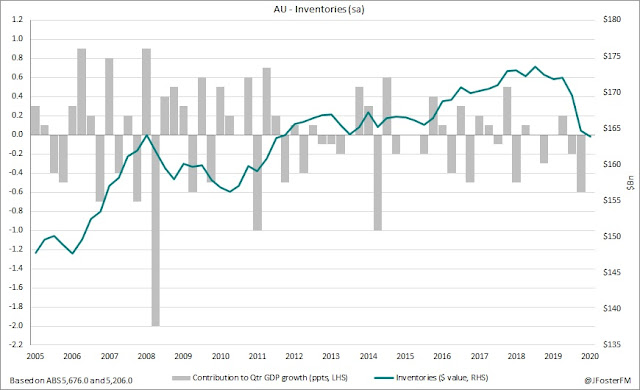The resumption of trade after the reopening of the domestic economy from its Covid-19 shutdown was the key theme from today's ABS Business Indicators data for the September quarter. Inventories will contribute positively to GDP growth in the quarter; the wages bill rebounded as firms called staff back to work, and company profits advanced as sales increased after the shutdown-disrupted Q2.
Business Indicators — Q3 | By the numbers- Inventories declined by 0.5%q/q in Q3 to $163.9bn, which was slightly better than forecast (-0.7%), as the annual pace was little changed at -4.6% from -4.5%.
- Company gross operating profits lifted by 3.2% to $117.4bn in Q3 on the reopening, coming after government subsidies drove a 15.8% surge in Q2. The combined effects have elevated the pace over the year to 18.6% from 13.1%.
- Wages and salaries rebounded by 2.4% in the quarter to $145.5bn after Q2's record contraction of 3.3%. The annual pace improved to 0.4% from -1.0%.
Business Indicators — Q3 | The details
The shutdown had profound effects on demand and trading conditions. Ahead of the shutdown was the period of stockpiling as households made preparatory purchases. The combined result was a very sharp contraction in inventories over the first half of the year (-4.2%). Inventories were lower again over Q3 (-0.5%), but at a greatly reduced pace (Q1 -1.4% and Q2 -2.9%), and so for GDP purposes this will constitute a sizeable positive contribution to output in the quarter. The two industries that contributed most were manufacturing (1.6%) and accommodation and food services (15.3%), but inventories continued to fall for wholesalers (-2.2%) and miners (-1.8%).
Growth in gross company profits was supported by the reopening of the economy rising by 3.2% overall in Q3 to be 18.6% higher through the year. In the June quarter, government subsidies supported firms by the transfer of incomes from the public to the private sector, and this continued into Q3. Remarkably, despite this being the first major economic downturn the nation has endured since the early 1990s, company profits are 19.6% higher than they were at the end of 2019. The outcomes have been very uneven; non-mining sector gross profits up by a further 9.9% after soaring by 29.9% in Q2, while mining gross profits were down 9.4% in Q3 and contracted by 3.9% in Q2. Benefitting most from the income transfers have been services-related industries that were heavily impacted by the containment measures, as seen by the extraordinary growth rates for gross operating profits shown in the summary table above in industries such as other services, administration, arts and recreation and accommodation and food. To be more consistent with how company profits are reported in the national accounts, an adjustment is made for changes in the valuation of inventories. Making this adjustment, gross company profits were 2.2% higher in Q3.
The story of the reopening is well conveyed through the chart below with the outturns for sales income across the economy rebounding in Q3 (green bars) compared to the collapse that occurred in Q2 (grey bars). The most extreme moves came in two of the hardest-hit industries by the restrictions in accommodation and food services and arts and recreation services.
The wages bill plunged by 3.3% in the June quarter (-1.0%Y/Y) as the shutdown led to upheaval in the labour market. With firms calling staff back to work and rehiring on the reopening, wage incomes rebounded by 2.4% in Q3 (0.4%Y/Y). At $145.5bn the level of wages is around 0.7% below its pre-pandemic baseline, but this is improved from a trough of -3.1% in Q2.
Business Indicators — Q3 | Insights
Today's report highlighted the improving trading conditions for firms brought on by the reopening of the Australian economy from its shutdown to contain the Covid-19 spread. Inventories will add to GDP growth in Q3, while the lifts recorded across company profits, sales and wages reflect the progress being made in the recovery.






